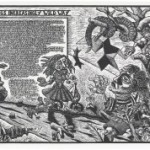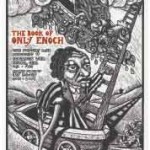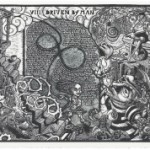To say that this exhibit is a must-see, is putting it mildly. The combined works are a command performance of an immense amount of work, inspiration, creativity and talent. Introduced by “The Jackleg Testament , Part I: Jack and Eve” an award-winning animated film featuring story, music and graphics, all by Jay Bolotin, and moving on to undreamed of intricacies in prints and drawings, it never fails to amaze. The 2007
Santa Fe Film Festival chose this as “Best of Animation”.
The first reaction is to the amount of work these images evidence. Bolotin has spent years on this and it’s not done yet. Each static image is covered with individual smaller images. Faces peer from detritus off-center, creating complex piles of background. Figures float in clouds, patterns add constant interest as floors, walls, and innocuous items take their places in the complicated dialogue.
In the film, all of the action and actors are woodcuts. They move, speak and grimace their parts supporting the story flamboyantly. Most threatening of all is The Serpent; scaly, evil, and definitely up to no good. Surrounding this scoundrel are the Bums, the prosperous people of The Western Region, Eve, Jack-in-the box, (a pseudo Adam) constantly woven through ominous scenery.
Unfortunately, the acoustics in Michelle Vance Waddell Gallery are not suitable for film sound but the action is hypnotic. Several people commented on not being able to understand the sound track, but stayed simply to watch. The operatic score was sung by well-known Cincinnati artist, Karin Bergquist, English tenor, Nigel Robson and German bass-baritone, Monte Jaffe with violin solo by Paul Patterson of the Cincinnati Symphony Orchestra.
Next door, The Manuel D. and Rhoda Mayerson Gallery exhibits the prints and text of the story, “Only Enoch”. Based on an obscure book left out of the Hebrew Testament, the prints tell the story of Enoch, the son of the sole Jewish coal miner in Fayette County. He was the only human to “spy on the angels and live to tell the tale”. Here his adventures are shown with the same intense imagery as the film. Copper intaglio forms the text in each of these and echo Bolotin’s signature style. Text is printed first, then the wood block. A case in the center of the room displays plate and block, offering an illustration of the process.
Mark Patsfall, owner of Clay Street Press, and his assistant Emily Sites spent over a year printing this edition, having destroyed earlier editions which weren’t quite right. The frustrations and problems that year must have encompassed become clear upon actually viewing the perfect 20 print edition.
In line with Bolotin’s sterling reputation in prints, there are also 12 super-drawings. By labeling them super, it’s obvious they’re beyond the preparatory pieces for which they were intended. These graphite examples are again perfect. Even the backgrounds are worked with delicate tonal design, so well matched and attentively detailed, at first glance they appear to be additional prints. The final prints, even more detailed and filled with information, end up barely related to the ornate drawings. A sincere admiration for William Blake’s aesthetic for combining poetry and visual imagery is evidenced in both the texted prints, and their methods of combination.
As this review progressed, a semi-autobiographical direction began to emerge along with some symbolic references. Eve bears an ancient feminine symbol on her cheek. One of Enoch’s cast is named Porko, the name of an old recording associate. Enoch’s referemces tp “The Kentucky Institute for the Criminally Insane and Slightly Upset” could refer to his early visits to a local institution playing his music for the inmates. Examine these prints carefully. Full disclosure on just one visit to “Enoch” could never yield all that’s hidden there. Just as Blake saw angels in London’s trees, despised the weight of organized government on mankind, Boloton manages to squeeze his philosophy subtly into Enoch with similar determination.
The extension of these two galleries of the exhibition are an opportunity to re-review, and better digest them. It now closes on March 12, 2017.
Of his creations Bolotin says, “Myth is something not relegated to the past, but is around us every day”. Particularly at CAM.
–Fran Watson







